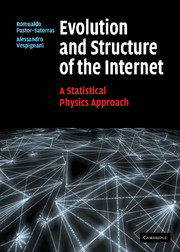Book contents
- Frontmatter
- Contents
- Preface
- List of abbreviations
- 1 A brief history of the Internet
- 2 How the Internet works
- 3 Measuring the global Internet
- 4 The Internet's large-scale topology
- 5 Modeling the Internet
- 6 Internet robustness
- 7 Virtual and social networks in the Internet
- 8 Searching and walking on the Internet
- 9 Epidemics in the Internet
- 10 Beyond the Internet's skeleton: traffic and global performance
- 11 Outlook
- Appendix 1 Graph theory applied to topology analysis
- Appendix 2 Interface resolution and router topology
- Appendix 3 Numerical analysis of heavy tailed distributions
- Appendix 4 Degree correlations
- Appendix 5 Scale-free networks: scaling relations
- Appendix 6 The SIR model of virus propagation
- References
- Index
2 - How the Internet works
Published online by Cambridge University Press: 12 January 2010
- Frontmatter
- Contents
- Preface
- List of abbreviations
- 1 A brief history of the Internet
- 2 How the Internet works
- 3 Measuring the global Internet
- 4 The Internet's large-scale topology
- 5 Modeling the Internet
- 6 Internet robustness
- 7 Virtual and social networks in the Internet
- 8 Searching and walking on the Internet
- 9 Epidemics in the Internet
- 10 Beyond the Internet's skeleton: traffic and global performance
- 11 Outlook
- Appendix 1 Graph theory applied to topology analysis
- Appendix 2 Interface resolution and router topology
- Appendix 3 Numerical analysis of heavy tailed distributions
- Appendix 4 Degree correlations
- Appendix 5 Scale-free networks: scaling relations
- Appendix 6 The SIR model of virus propagation
- References
- Index
Summary
While the scope of this book is to look at the Internet as a self-organizing complex system and to study its large-scale properties by using a statistical approach, a general knowledge of how the Internet works is necessary to identify the main elements forming the Internet, as well as their respective interactions. To give a physical analogy, if we want to understand the properties of a certain material we first have to know the atomic elements it is composed of, and how they interact. Similarly, it is impossible to approach the Internet without first having some hint of what a router is and how it communicates with its peers.
In this chapter we provide a brief description of the different elements, both hardware and software, at the basis of the Internet's functioning, to allow the non-expert readers to familiarize themselves with the general mechanisms that make it possible to transfer data from host to host. These mechanisms will turn out to be very relevant for understanding problems related with measurement infrastructures and other communication processes taking place in the Internet. Our exploration of the Internet's workings will be necessarily non-technical and, needless to say, the expert reader can freely skip this chapter and use it later on for convenient reference.
Physical description
In providing a general picture of the Internet, the starting point is the concept of a computer network. A network is any set of computers – usually referred to as hosts – connected in such a way that each one of them can inter-operate with all the others.
- Type
- Chapter
- Information
- Evolution and Structure of the InternetA Statistical Physics Approach, pp. 10 - 18Publisher: Cambridge University PressPrint publication year: 2004



